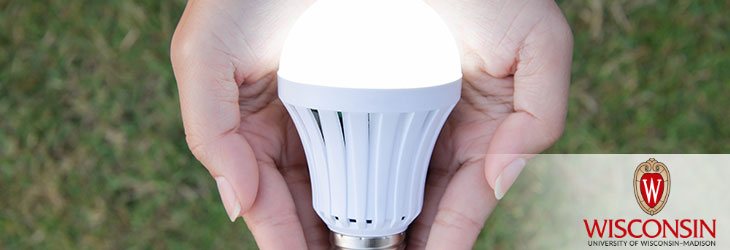Clean Technology

Using UV Light to Functionalize Metal Oxides for Use in Biosensors, Solar Cells and Other Devices
WARF: P09033US
Inventors: Robert Hamers, Bo Li, Elizabeth Landis, Ryan Franking
The Wisconsin Alumni Research Foundation (WARF) is seeking commercial partners interested in developing methods for functionalizing metal oxides using UV light. The functionalized metal oxides are suitable for use in biosensors, dye-sensitized solar cells and other applications.
Overview
Functionalized substrates have commercial applications ranging from biosensors to energy conversion devices such as solar cells. Biosensors rapidly detect the presence of target biomolecules based on known interactions between the analytes and other biomolecules immobilized on a substrate. However, existing technologies for immobilizing biomolecules are limited by poor repeatability and instability, resulting in increased manufacturing costs and short shelf life.
Oxide materials, particularly TiO2, often are used in energy conversion devices. Bonding molecules, including dye molecules, to the surface of TiO2 provides a way to modify the optical properties and enhance the performance of devices such as dye-sensitized solar cells. But it is difficult to effectively link molecules to titanium coated surfaces.
More efficient methods for linking molecules to metal oxides and metal oxide-coated substrates are needed.
Oxide materials, particularly TiO2, often are used in energy conversion devices. Bonding molecules, including dye molecules, to the surface of TiO2 provides a way to modify the optical properties and enhance the performance of devices such as dye-sensitized solar cells. But it is difficult to effectively link molecules to titanium coated surfaces.
More efficient methods for linking molecules to metal oxides and metal oxide-coated substrates are needed.
The Invention
UW-Madison researchers have developed methods for functionalizing metal oxides, including TiO2, with organic molecules. The methods use UV light to covalently bond linker precursors to the surface of a metal oxide. Then other molecules, such as dye molecules or biomolecules like DNA, can be coupled to the linker precursors to further functionalize the metal oxides.
The functionalized oxides may be used alone or as coatings on various substrates. They can be incorporated into devices such as biosensors or dye-sensitized solar cells.
These methods provide functionalized metal oxides with higher densities of organic molecules and greater thermal and chemical stability than functionalized metal oxides prepared using conventional methods. In addition, these methods do not require high temperatures or an ultra high vacuum, and are simpler and more reproducible than conventional methods.
The functionalized oxides may be used alone or as coatings on various substrates. They can be incorporated into devices such as biosensors or dye-sensitized solar cells.
These methods provide functionalized metal oxides with higher densities of organic molecules and greater thermal and chemical stability than functionalized metal oxides prepared using conventional methods. In addition, these methods do not require high temperatures or an ultra high vacuum, and are simpler and more reproducible than conventional methods.
Applications
- Solar cells
- Biosensors
- Biomolecular arrays, including protein, DNA and RNA arrays
- Functionalized coatings for glass, plastic and other materials
Key Benefits
- Simpler and more reproducible than conventional methods
- Does not require high temperatures or an ultra high vacuum
- Provides higher densities of organic molecules
- Provides functionalized metal oxides with excellent thermal and chemical stability
- Allows portions of the metal oxides to be photo-patterned with specific linker precursors on particular areas on the substrate
- Provides high sensitivity for fluorescence detection due to low quenching of TiO2 and high local surface area in the nanocrystalline form
- Enables other optical surface measurements, such as surface plasmon resonance (SPR) detection, with the use of metallic substrates
Stage of Development
A variety of molecules have been grafted to the surface of TiO2 and ZnO2. Other organic alkenes were bonded and tested for heat stability over long periods with no detectable degradation.
Additional Information
For More Information About the Inventors
For current licensing status, please contact Mark Staudt at [javascript protected email address] or 608-960-9845